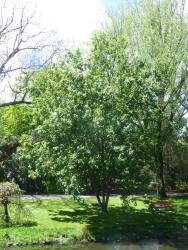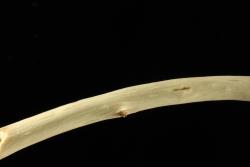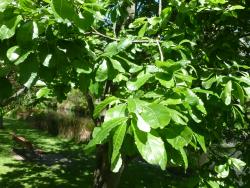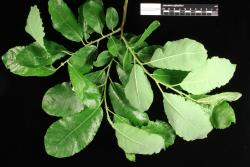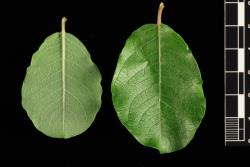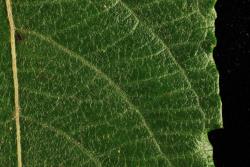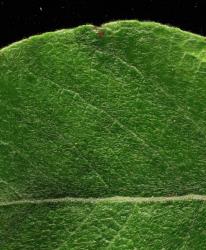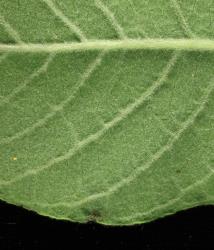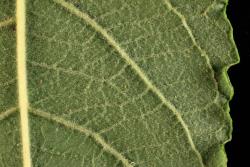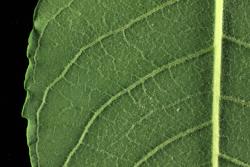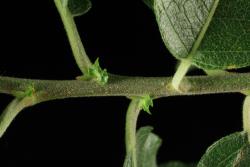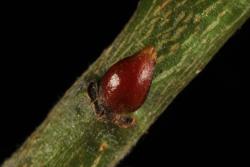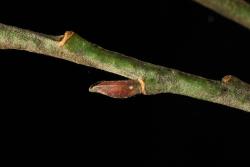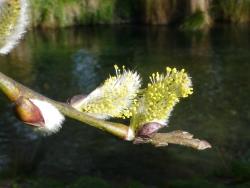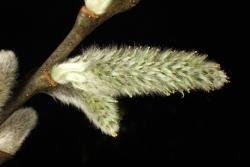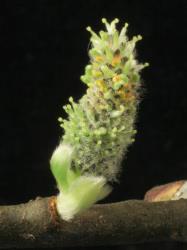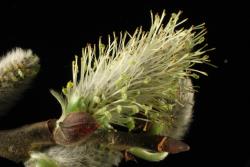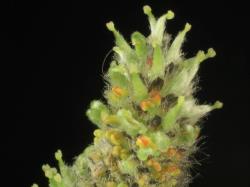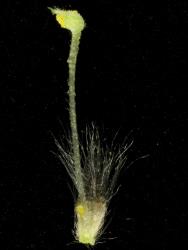Multi-stemmed shrubs to 6 m; bark smooth; branchlets erect; wood ridges 4–8 mm long (average 5 mm long), dense. Current year's branchlets densely velvety, hairs persisting somewhat, greyish-brown (UCL61). Year-old branchlets greyish olive (UCL110), tomentum persisting but rubbed off in places, diameter 3.7–5.2 mm. Flower bud scales 9.5–10 mm long, 5.2 mm wide, 3.8 mm deep, ovoid, with 2 angles, dark red-brown (UCL44), moderately dense short-silky hairs rubbing off. Leaves alternate. Stipule 7 mm long, asymmetrically ovate, not persisting. Petiole 20–30 mm long, densely tomentose, glands absent, base of petiole pinky red. Emerging leaves with lower surface densely tomentose, upper surface moderately densely tomentose, green. Proximal leaves entire. Leaf lamina 68–148 mm long, 30–71 mm wide, length to width ratio 2.3–2.6:1, elliptical or obovate; base rounded; apex acute to acuminate; leaf galls absent; orange rust sparse in late summer; margins serrate, undulate, finely revolute; upper lamina surface finely rugose, slightly glossy, glabrous except midvein tomentose, stomata absent; lower lamina surface midvein, side-veins, and netted veins raised, surface slightly glaucous, moderately densely tomentose, hairs persisting. Catkins male, female, or androgynous, teratogenic flowers common, catkins emerging before leaves. Flowering branch 17–50 mm long with 4 leaves below the catkin. Catkins 17–45 mm long, elongating to 70 mm after flowering, 13 mm diameter; catkin rachis not visible between flowers. Flower bract 2.4–4.2 mm long, 0.8–1.0 mm wide, black distally, brown in the middle, hyaline in lower half, flat; apex acute, long-silky hairs all over. Male nectary 1, 0.6–0.8 mm long, 0.26–0.28 mm wide, yellow. Stamens 2 (or 1 in androgynous flowers), filaments free, hairs present throughout (in androgynous flowers) or in lower half of filament; anthers 0.8–1.0 mm long, yellow. Female nectary 1, 0.6–0.7 mm long, 0.3–0.4 mm wide, pale yellow; ovary 3–6 mm long, densely short-silky hairy, longer than the flower bract, stalk 2.2–3.1 mm long; style base 0.5–0.6 mm long, style arms 0.2–0.3 mm long, unlobed, hyaline.
Leaves are large (late summer leaf lamina 68–148 mm long, 30–71 mm wide), elliptical to obovate, the margins coarsely toothed and undulate and the margin finely revolute, glaucous below, with stomata only on the lower surface. Unusual in its winter flowering (July–August), much earlier than any other willows present in New Zealand.
Similar to Salix apennina and S. caprea. Wood ridges are dense as in S. atrocinerea and S. cinerea but are much shorter, averaging 5 mm long, not 17 or 21 mm long. Similar to S. apennina in leaf size, undulation and toothing, but differs in the leaves being sparsely tomentose below, whereas S. apennina is glabrous below.
Known in cultivation at Gisborne (Hackfalls Arboretum 1972), Southern North Island (Aokautere), Canterbury (Christchurch Botanic Gardens 1984–2018, Prebbleton 2018, Timaru Botanic Gardens 1961), and likely to be present in other public and private gardens in New Zealand.
First collection: CHR 130116, W. R. Sykes, 11 September 1962, Christchurch Botanic Gardens.
First publication: This publication.
Flowering: Early July–early August.
Salix aegyptiaca is said to be diploid, 2n = 38 (Khalili et al. 2012). Flow cytometry of three New Zealand hybrid plants provisionally indicates they are tetraploid.
The vernacular name musk willow refers to a scent that was extracted from the flowers of Salix aegyptiaca. The flowers of the New Zealand hybrid plants do not have this scent.
The parent species Salix aegyptiaca L. was published in Cent. Pl. 1: 53 (1755).



